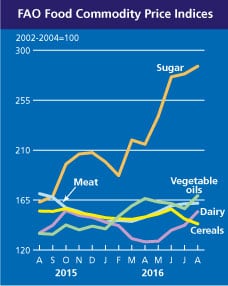The FAO Food Price Index – a measure of the monthly change in international prices of a basket of food commodities – showed a 1.9% increase compared with the previous month and was up almost 7% on figures for August 2015.
This increase was driven mostly by cheese and palm oil quotations, it said, while those for cereals – wheat, maize and rice – all fell.
Bumper grain crops
The organisation has raised its forecast for global cereal production or 2016 by 22 million tonnes to 741m tonnes, anticipating a record global wheat harvest this year as well as a bumper maize harvest in the US.
This will boost inventories and push up the global stock-to-use grain ratio to 25.3%, making for an "even more comfortable (supply and demand) situation than predicted at the start of the season," it said.

The organisation has also predicted that Russia will overtake the European Union to become the world’s biggest wheat exporter in 2016/2017 after wet weather in Europe damaged crops.
But apart from the fall in the grain price index – which dipped 3% from July to August, putting it 7.4% lower than August last year, the organisation’s trade-weighted index showed the index for all other commodities moving upwards.
The dairy index rose 8.6% during August, with prices rising for all the goods that make up the FAO’S basket of dairy goods, particularly for cheese, whole milk powder and butter.
“[This] confirms a notable change in market sentiment linked to falling milk production in the EU and a tightening of export supply prospects after an unexceptional opening to the dairy year in Oceania,” it said.
Vegetable oil prices also rose by 7.4%, fuelled mainly by strong prices for palm oil. This was due to lower output than expected from palm oil producers in Malaysia and rising demand for imports from China, India and Europe.
Meanwhile the price of sugar rose 2.5% between July and August, nearly 75% higher than last year and putting the commodity at its highest level in almost six years. “A stronger currency in Brazil, by far the world's largest producer of sugar cane, drove much of the gain as it limited export supplies with producers preferring to sell to the local markets.”
Meat on the other hand remained broadly stable, rising 0.3% since July.
